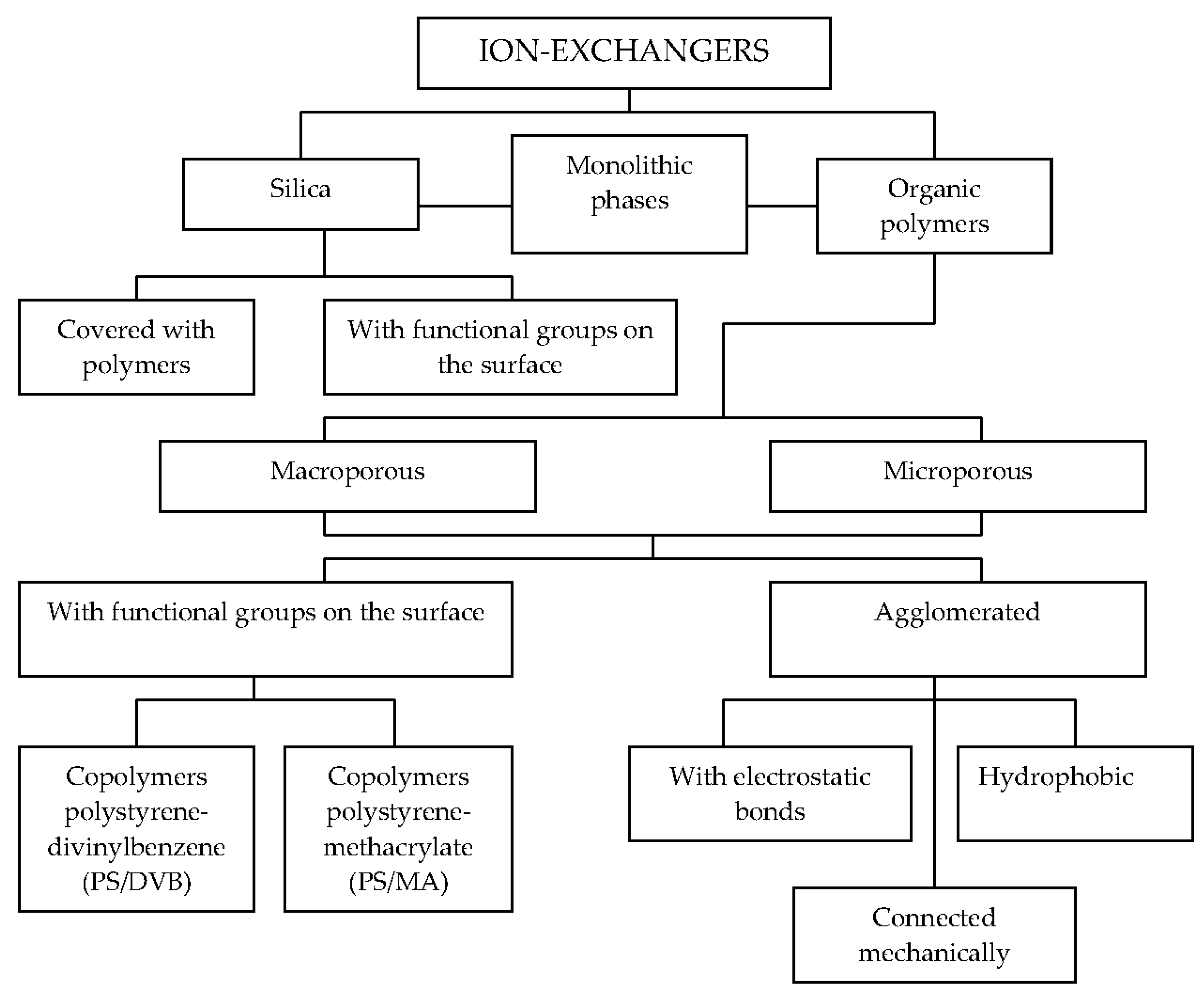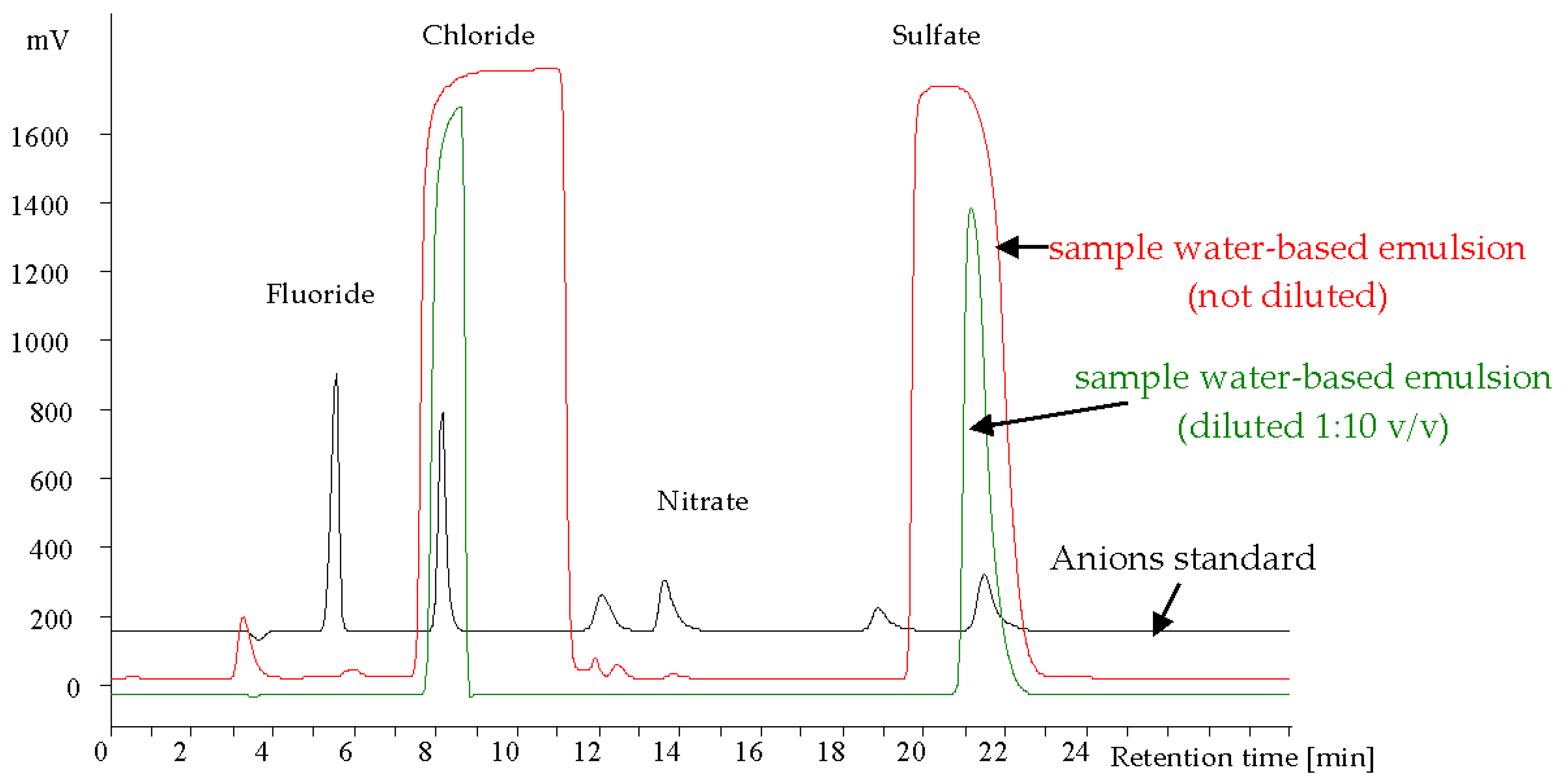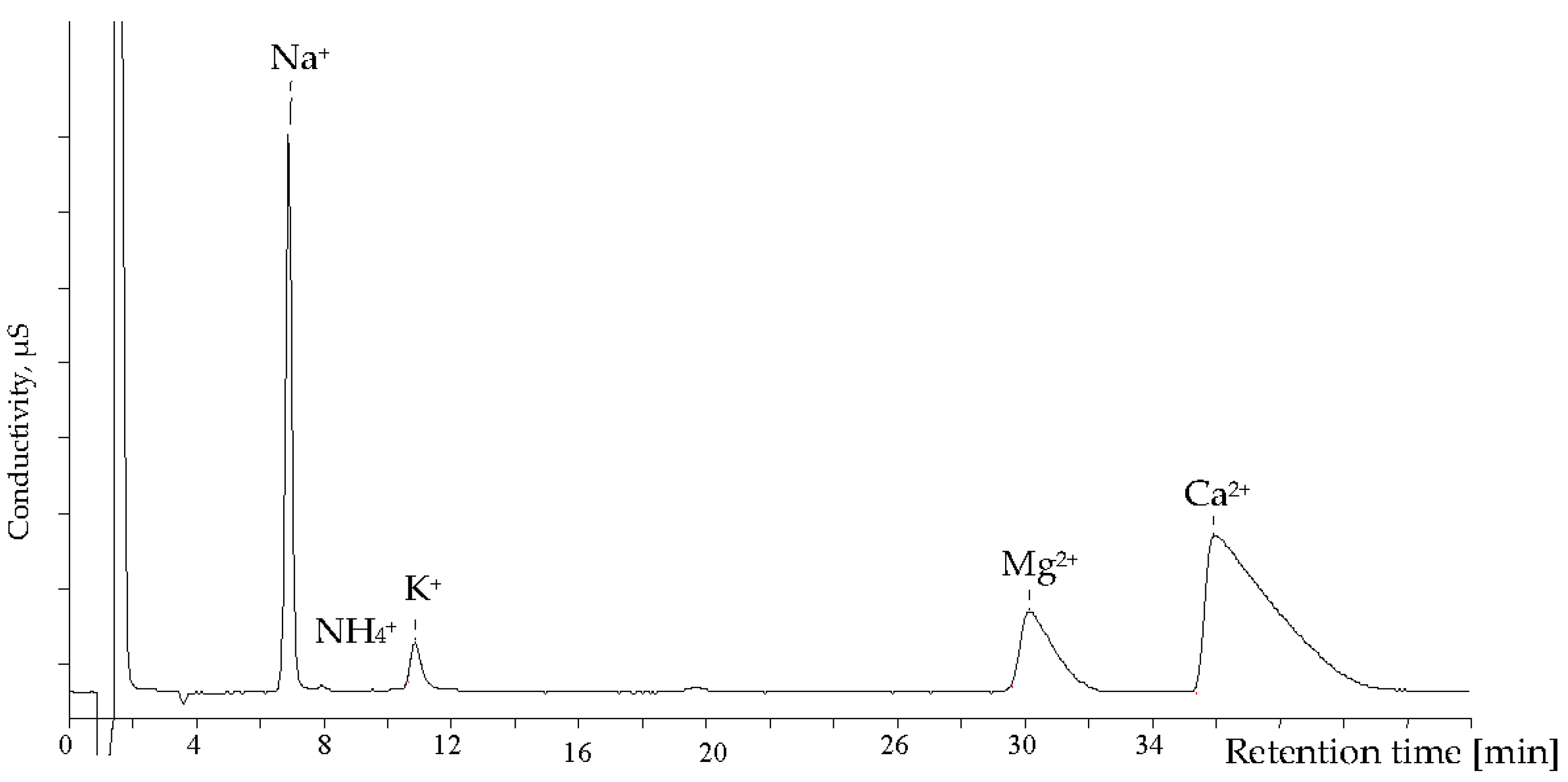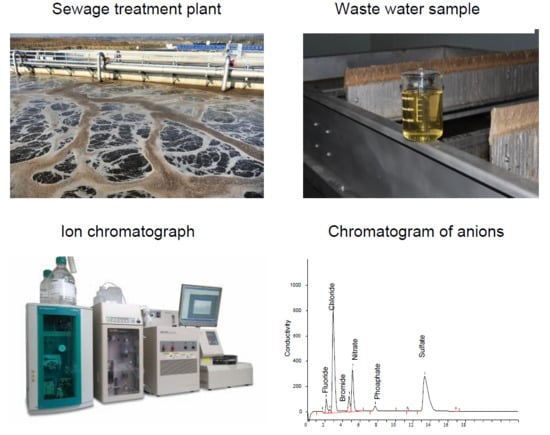Ion Chromatography Applications in Wastewater Analysis
Abstract
:1. Introduction
2. Sample Preparation
3. Wastewater Analysis with Ion Chromatography
4. Standard Methods Based on Ion Chromatography
5. Conclusions
Conflicts of Interest
References
- Tswett, M.S. Physikalisch-Chemische Studien Uber das Chlorophyll. Die Adsorptionen. Ber. Bot. Ges. 1906, 24, 316–332. [Google Scholar]
- Small, H.; Stevens, T.S.; Bauman, W.C. Novel Ion Exchange Chromatographic Method Using Conductometric Detection. Anal. Chem. 1975, 47, 1801–1806. [Google Scholar] [CrossRef]
- Small, H.; Bowman, B. Ion Chromatography: A Historical Perspective. Am. Lab. 1998, 10, 1–8. [Google Scholar]
- Gjerde, D.T.; Fritz, J.S.; Schmuckler, G. Anion Chromatography with Low-Conductivity Eluents. J. Chromatogr. A 1978, 186, 509–513. [Google Scholar] [CrossRef]
- Gjerde, D.T.; Fritz, J. Ion Chromatography; Wiley-VCH: Weinheim, Germany, 2000. [Google Scholar]
- Jackson, P.; Haddad, P.R. Ion Chromatography: Principles and Applications; Elsevier: Amsterdam, The Netherlands, 1990. [Google Scholar]
- Fritz, J.S. Principles and applications of ion-exclusion chromatography. J. Chromatogr. A 1991, 546, 111–118. [Google Scholar] [CrossRef]
- Cecchi, T. Ion-Pair Chromatography and Related Techniques. J. Am. Chem. Soc. 2010, 132, 1732. [Google Scholar]
- Gennaro, M.C.; Angelino, S. Separation and determination of inorganic anions by reversed-phase high-performance liquid chromatography. J. Chromatogr. A 1997, 789, 181–194. [Google Scholar] [CrossRef]
- Quereshi, M.; Varshney, K.G. Inorganic Ion Exchangers in Chemical Analysis; CRC Press: Boston, MA, USA, 1991. [Google Scholar]
- Weiss, J.; Jensen, D. Modern stationary phases for ion chromatography. Anal. Bioanal. Chem. 2003, 375, 81–98. [Google Scholar] [CrossRef] [PubMed]
- Jackson, P.E.; Pohlandt, C. Advances in stationary phase development in suppressed ion chromatography. Trend. Anal. Chem. 1997, 16, 393–400. [Google Scholar] [CrossRef]
- Jackson, P.E.; Weigert, C.; Pohl, C.A.; Saini, C. Determination of inorganic anions in environmental waters with a hydroxide-selective column. J. Chromatogr. A 2000, 884, 175–184. [Google Scholar] [CrossRef]
- Krokhin, O.V.; Smolenkov, A.D.; Svintsova, N.V.; Obrezkov, O.N.; Shipgun, O.A. Modified silica as a stationary phase for ion chromatography. J. Chromatogr. A 1995, 706, 93–98. [Google Scholar] [CrossRef]
- Auler, L.M.; Silva, C.R.; Collins, K.E.; Collins, C.H. New stationary phase for anion-exchange chromatography. J. Chromatogr. A 2005, 1073, 147–153. [Google Scholar] [CrossRef] [PubMed]
- Chiou, C.-S.; Shih, J.-S. Fullerene C60-cryptand chromatographic stationary phase for separations of anions/cations and organic molecules. Anal. Chim. Acta 2000, 416, 169–175. [Google Scholar] [CrossRef]
- Tong, C.; Shan, Z.L.; Zhu, P.L. Preparation of silica-based cation-exchangers for use in ion chromatography. Chromatographia 1989, 27, 316–320. [Google Scholar] [CrossRef]
- Ohta, K. Indirect ultraviolet spectrophotometric detection in the ion chromatography of common mono- and divalent cations on an aluminum adsorbing silica gel column with tyramine-containing crown ethers as eluent. J. Chromatogr. A 2000, 884, 113–122. [Google Scholar] [CrossRef]
- Nesterenko, P.N.; Elefterov, A.I.; Tarasenko, D.A.; Shpigun, O.A. Selectivity of chemically bonded zwitterion-exchange stationary phases in ion chromatography. J. Chromatogr. A 1995, 706, 59–68. [Google Scholar] [CrossRef]
- Pohl, C. Recent developments in ion-exchange and low molecular weight molecules. LC-GC 2003, 28, 24–31. [Google Scholar]
- Paull, B.; Nesterenko, P.N. New possibilities in ion chromatography using porous monolithic stationary-phase media. Trend Anal. Chem. 2005, 24, 295–303. [Google Scholar] [CrossRef]
- Michalski, R. Detection in Ion Chromatography. In Encyclopedia of Chromatography, 3rd ed.; Cazes, J., Ed.; Taylor & Francis: Milton Park, UK; CRC Press: Boca Raton, FL, USA, 2010; Volume I, pp. 576–580. ISBN 978-1-4200-8459-7. [Google Scholar]
- Buchberger, W.W. Detection techniques in ion chromatography of inorganic ions. Trend. Anal. Chem. 2001, 20, 296–303. [Google Scholar] [CrossRef]
- Connolly, D.; Paull, B. Fast separation of UV absorbing anions using ion-interaction chromatography. J. Chromatogr. A 2001, 917, 353–359. [Google Scholar] [CrossRef]
- Karmarkar, S.V. Anion-exchange chromatography of metal cyanide complexes with gradient separation and direct UV detection. J. Chromatogr. A 2002, 956, 229–235. [Google Scholar] [CrossRef]
- Dasgupta, P.K. Postcolumn techniques: A critical perspective for ion chromatography. J. Chromatogr. Sci. 1989, 27, 422–444. [Google Scholar] [CrossRef]
- Derbyshire, M.; Lamberty, A.; Gardiner, P.H. Optimization of the simultaneous determination of Cr(VI) and Cr(VI) by ion chromatography with chemiluminescence detection. Anal. Chem. 1999, 19, 4203–4207. [Google Scholar] [CrossRef] [PubMed]
- Miura, Y.; Hatakeyama, M.; Hosino, T.; Haddad, P.R. Rapid ion chromatography of l-ascorbic acid, nitrite, sulfite, oxalate, iodide and thiosulfate by isocratic elution utilizing a postcolumn reaction with cerium(IV) and fluorescence detection. J. Chromatogr. A 2002, 956, 77–84. [Google Scholar] [CrossRef]
- Tirumalesh, K. Simultaneous determination of bromide and nitrate in contaminated waters by ion chromatography using amperometry and absorbance detectors. Talanta 2008, 74, 1428–1434. [Google Scholar] [CrossRef] [PubMed]
- Buldini, P.L.; Cavalli, S.; Mevoli, A.; Sharma, J.L. Ion chromatographic and voltamperometric determination of heavy and transition metals in honey. Food Chem. 2001, 73, 487–495. [Google Scholar] [CrossRef]
- Wong, D.; Jandik, P.; Jones, W.R.; Haganaars, A. Ion chromatography of polyphosphates with direct refractive index detection. J. Chromatogr. A 1987, 389, 279–285. [Google Scholar] [CrossRef]
- Zwiener, C.; Frimmel, F.H. LC-MS analysis in the aquatic environment and in water treatment—A critical review—Part I: Instrumentation and general aspects of analysis and detection. Anal. Biochem. Chem. 2004, 378, 851–861. [Google Scholar] [CrossRef] [PubMed]
- Michalski, R.; Jablonska, M.; Szopa, S.; Łyko, A. Application of Ion Chromatography with ICP-MS or MS Detection to the Determination of Selected Halides and Metal/Metalloids Species. Crit. Rev. Anal. Chem. 2011, 41, 133–150. [Google Scholar] [CrossRef]
- Haddad, P.R.; Nesterenko, P.N.; Buchberger, W. Recent developments and emerging directions in ion chromatography. J. Chromatogr. A 2008, 1184, 456–473. [Google Scholar] [CrossRef] [PubMed]
- Smith, R. Before the injection—modern methods of sample preparation for separation techniques. J. Chromatogr. A 2003, 1000, 3–27. [Google Scholar] [CrossRef]
- Saubert, A.; Frenzel, W.; Schafer, H.; Bogenschutz, G.; Schafer, J. Sample Preparation Techniques for Ion Chromatography; Metrohm: Herisau, Switzerland, 2004. [Google Scholar]
- Slingby, R.; Kaiser, R. Sample treatment techniques and methodologies for ion chromatography. Trends Anal. Chem. 2001, 20, 288–295. [Google Scholar] [CrossRef]
- Frenzel, W.; Michalski, R. Sample Preparation Techniques for Ion Chromatography. In Application of IC-MS and IC-ICP-MS in Environmental Research; Michalski, R., Ed.; John Wiley & Sons, Inc.: Hoboken, NJ, USA, 2016; pp. 210–266. ISBN 9781118862001. [Google Scholar]
- Miro, M.; Frenzel, W. The potential of microdialysis as an automatic sample-processing technique for environmental research. Trends Anal. Chem. 2005, 24, 324–333. [Google Scholar] [CrossRef]
- Saari-Nordhaus, R.; Nair, L.M.; Anderson, J.M. Elimination of matrix interferences in ion chromatography by the use of solid phase extraction discs. J. Chromatogr. A 1994, 671, 159–163. [Google Scholar] [CrossRef]
- Howe, K.J.; Hand, D.W.; Crittenden, J.C.; Trussell, R.R.; Tchobanoglous, G. Principles of Water Treatment; Wiley: Hoboken, NJ, USA, 2012; ISBN 978-0-470-40538-3. [Google Scholar]
- Jackson, P.E. Ion chromatography in environmental analysis. In Encyclopedia of Analytical Chemistry; Meyers, R.A., Ed.; Wiley: Chichester, UK, 2000; pp. 2779–2801. [Google Scholar]
- Weiss, J. Handbook of Ion Chromatography, Fourth, Completely Revised and Enlarged Edition; Wiley-VCH, Verlag GmbH&Co. KGaA: Weinheim, Germany, 2016; Volumes 1–3. [Google Scholar]
- Singh, R.P.; Abbas, N.M.; Smesko, S.A. Suppressed ion chromatography analysis of anions in environmental waters containing high salt concentration, J. Chromatogr. A 1996, 733, 73–91. [Google Scholar] [CrossRef]
- Otu, E.O.; Byerley, J.J.; Robinson, C.W. Ion chromatography of cyanide and metal cyanide complexes: A review. Int. J. Environ. Anal. Chem. 1996, 63, 81–90. [Google Scholar] [CrossRef]
- Ruiz-Calero, V.; Galceran, M.T. Ion chromatographic separations of phosphorus species: A review. Talanta 2005, 66, 376–410. [Google Scholar] [CrossRef] [PubMed]
- Michalski, R. Trace Level Determination of Cr(III)/Cr(VI) in Water Samples Using Ion Chromatography with UV Detection. J. Liq. Chromatogr. Relat. Technol. 2005, 28, 2849–2862. [Google Scholar] [CrossRef]
- Ellis, L.A.; Roberts, D.J. Chromatographic and hyphenated methods for elemental speciation analysis in environmental media. J. Chromatogr. A 1997, 774, 3–19. [Google Scholar] [CrossRef]
- Michalski, R. (Ed.) Application of IC-MS and IC-ICP-MS in Environmental Research; John Wiley & Sons, Inc.: Hoboken, NJ, USA, 2016; pp. 1–269, ISBN 9781118862001 (cloth). ISBN 9781119085478 (epub). [Google Scholar]
- Shaw, M.J.; Haddad, P.R. The determination of trace metal pollutants in environmental matrices using ion chromatography. Environ. Int. 2004, 30, 403–431. [Google Scholar] [CrossRef] [PubMed]
- Sarzanini, C.; Bruzzoniti, M.C. Metal species determination by ion chromatography. Trends Anal. Chem. 2001, 20, 304–310. [Google Scholar] [CrossRef]
- Michalski, R. Ion Chromatography as a Reference Method for The Determination of Inorganic Ions in Water and Waste water. Crit. Rev. Anal. Chem. 2006, 36, 107–127. [Google Scholar] [CrossRef]
- Michalski, R. Application of ion chromatography for the determination of inorganic cations. Crit. Rev. Anal. Chem. 2009, 39, 230–250. [Google Scholar] [CrossRef]




| Method | Separation Mechanism | Functional Group | Typical Eluents | Selected Analytes | Detection Modes |
|---|---|---|---|---|---|
| Anion-exchange chromatography (suppressed and non-suppressed) | Ion-exchange | –NR3+ | Suppressed ion chromatography:
Na2CO3 + NaHCO3, NaOH, KOH Non-suppressed ion chromatography: benzioc acid, phtalic acid, aromatic and aliphatic carboxylic acids, sulfonic acid | F−, Cl−, Br−, I−, ClO2−, ClO3−, ClO4−, BrO3−, HPO42−, SCN−, CN−, P2O74−, NO2−, NO3−, S2−, SO32−, SO42−, S2O32−, AsO32−, WO42−, MnO42−, CrO42−, SiO32−, SeO32−, SeO42−, SiF6−, Cr4O72−, BF4−, carboxylic acids, | Conductivity, UV-VIS, amperometric, MS, ICP-MS |
| Cation-exchange chromatography (suppressed and non-suppressed) | Ion-exchange | –SO3− | Suppressed ion chromatography:
H2SO4, HCl, HNO3, methylosulfonic acid (MSA) Non-suppressed ion chromatography: HNO3, tartaric acid, dipicolinic acid (DPA) | Rb+, Cs+, Li+, Na+, K+, NH4+, Mg2+, Ca2+, Ba2+, Sr2+, aliphatic amines | Conductivity, UV-VIS, MS, ICP-MS |
| –SO3−/NR3+ | 2,4-pyridinedicarboxylic acid
(PDCA), oxalic acid | Cu2+, Ni2+, Cd2+, Pb2+, Mn2+, Fe2+, Fe3+, Sn2+, Zn2+, Co2+, Sn4+, Cr3+, As3+, As5+, UO22+, La3+, Ce3+, P3+, Nd3+, Sm3+, Eu3+, V4+, V5+, Gd3+, Tb3+, Dy3+, Tm3+, Yb3+, Ho3+, Er3+, Lu3+, Am3+, Pu3+ | UV-VIS, MS, ICP-MS | ||
| Ion-exclusion chromatography | Ion-exclusion | –SO3−/NR3+ | Water, diluted mineral acids, | ClO4−, I−, BrO4−, Cl−, NO2−, NO3−, carboxylic acids, aldehydes, silicates, amines, carbohydrates | Conductivity, UV-VIS, amperometric |
| Anion-pair chromatography | Ion-pairs | Neutral | NH4OH, tetramethylammonium hydroxide (TMAOH), tetrapropylammonium hydroxide (TPAOH), tetrabutylammonium hydroxide (TBAOH) | F−, Cl−, Br−, I−, SCN−, CN−, ClO3−, ClO4−, BrO3−, NO2−, NO3−, SO32−, SO42−, SeO32−, SeO42−, anionic surfactants, metal complexes, aromatic carboxylic acids | Conductivity, UV-VIS |
| Cation-pair chromatography | Neutral | aliphatic sulfonated hydrocarbons, (C2–C10), selected inorganic anions (e.g., PF6−, complexing agents) | Li+, Na+, K+, NH4+, Rb+, Cs+, Mg2+, Ca2+, Ba2+, Sr2+, alkylamines, alkanolamines, cationic surfactants, sulfonic and phosphonium compounds | Conductivity, UV-VIS |
| Detection Mode | Principle | Example Applications |
|---|---|---|
| Conductivity | Electrical conductivity | Anions and cations with pKa or pKb < 7 |
| Direct and indirect UV-VIS | UV-VIS light absorption | UV-active anions and cations, heavy and transition metals after post column derivatisation reaction |
| Fluorescence | Excitation and emission | Ammonium, amino acids, and selected amines after post column derivatisation |
| Amperometry | Oxidation or reduction | Anions and cations with pKa or pKb > 7 |
| MS | Electrospray ionization | Hyphenation technique for structural characterization of organic anions and cations |
| ICP-AES, ICP-MS | Atomic emission | Hyphenation techniques for species analysis of metal and metalloids |
| Refractive index | Change in refractive index | High concentrated samples |
| Method Number | Method Name | Analytes | Method of Detection |
|---|---|---|---|
| ISO Methods (https://www.iso.org/standards.html, accessed 10 September 2017) | |||
| ISO 10304-2 | Water Quality—Determination of Dissolved Anions by Liquid Chromatography of Ions. Part 2: Determination of Bromide, Chloride, Nitrate, Nitrite, Orthophosphate and Sulfate in Waste Waters | Br−, Cl−, NO3−, NO2− PO43−, SO42− | Conductivity or UV (200–215 nm) |
| ISO 10304-3 | Water Quality—Determination of Dissolved Anions by Liquid Chromatography of Ions Part 3: Determination of Chromate, Iodide, Sulfite, Thiocyanate, and Thiosulfate | CrO42−, I−, SO32−, SCN−, S2O32− | Conductivity or UV (λ = 205 nm–220 nm); Amperometry (0.7 V–1.1 V) |
| ISO 14911 | Water Quality—Determination of Dissolved Li+, Na+, NH4+, K+, Mn2+, Ca2+, Mg2+, Sr2+ and Ba2+ Using Ion Chromatography Method | Li+, Na+, NH4+, K+, Mn2+, Ca2+, Mg2+, Sr2+, Ba2+ | Conductivity |
| US EPA Methods (https://www.epa.gov/ accessed 5 September 2017) | |||
| 300.0 | Determination of Inorganic Anions by Ion Chromatography | F−, Br−, Cl−, NO3−, NO2−, PO43−, SO42− | Conductivity |
| 200.10 | Determination of Trace Elements in Marine Waters by On-Line Chelation Preconcentration and Inductively-Coupled Plasma—Mass Spectrometry | Cd2+, Co2+, Cu2+, Pb2+, Ni2+, VO2+, VO22+, UO22+ | UV-VIS, ICP-MS |
| 200.13 | Determination of Trace Elements in Marine Waters by Off-Line Chelation Preconcentration with Graphite Furnace Atomic Absorption | Cd2+, Co2+, Cu2+, Pb2+, Ni2+ | UV-VIS, ICP-MS |
| 300.7 | Dissolved Sodium, Ammonium, Potassium, Magnesium, and Calcium in Wet Deposition by Chemically Suppressed Ion Chromatography | Na+, NH4+, K+, Mg2+, Ca2+ | Conductivity |
| ASTM Methods (https://www.astm.org/ accessed 11 September 2017) | |||
| D 4327-97 | Standard Test Method for Anions in Water by Suppressed Ion Chromatography | F−, Br−, Cl−, NO3−, NO2−, PO43−, SO42− | Conductivity |
| D19.05.03.23 | Standard Test Method for Determination of Inorganic Cations and Ammonia in Water and Waste water by Ion Chromatography | Li+, Na+, NH4+, K+, Mg2+, Ca2+ | Conductivity |
| D 6919-03 | Standard Test Method for Determination of Dissolved Alkali and Alkaline Earth Cations and Ammonium in Water and Waste water by Ion Chromatography | Li+, Na+, NH4+, K+, Mg2+, Ca2+ | Conductivity |
| UOP 959-98 | Ammonium Determination in Aqueous Solutions by Ion Chromatography | NH4+ | Conductivity |
| NIOSH Methods (https://www.cdc.gov/niosh/docs/2003-154/default.html accessed 15 September 2017) | |||
| 7405 | Alkali Metals Cations Li+, Na+, K+ | Li+, Na+, K+ | Conductivity |
| 7605 | Chromium Hexavalent by Ion Chromatography | CrO42− | UV-VIS (540 nm) |
© 2018 by the author. Licensee MDPI, Basel, Switzerland. This article is an open access article distributed under the terms and conditions of the Creative Commons Attribution (CC BY) license (http://creativecommons.org/licenses/by/4.0/).
Share and Cite
Michalski, R. Ion Chromatography Applications in Wastewater Analysis. Separations 2018, 5, 16. https://doi.org/10.3390/separations5010016
Michalski R. Ion Chromatography Applications in Wastewater Analysis. Separations. 2018; 5(1):16. https://doi.org/10.3390/separations5010016
Chicago/Turabian StyleMichalski, Rajmund. 2018. "Ion Chromatography Applications in Wastewater Analysis" Separations 5, no. 1: 16. https://doi.org/10.3390/separations5010016
APA StyleMichalski, R. (2018). Ion Chromatography Applications in Wastewater Analysis. Separations, 5(1), 16. https://doi.org/10.3390/separations5010016





